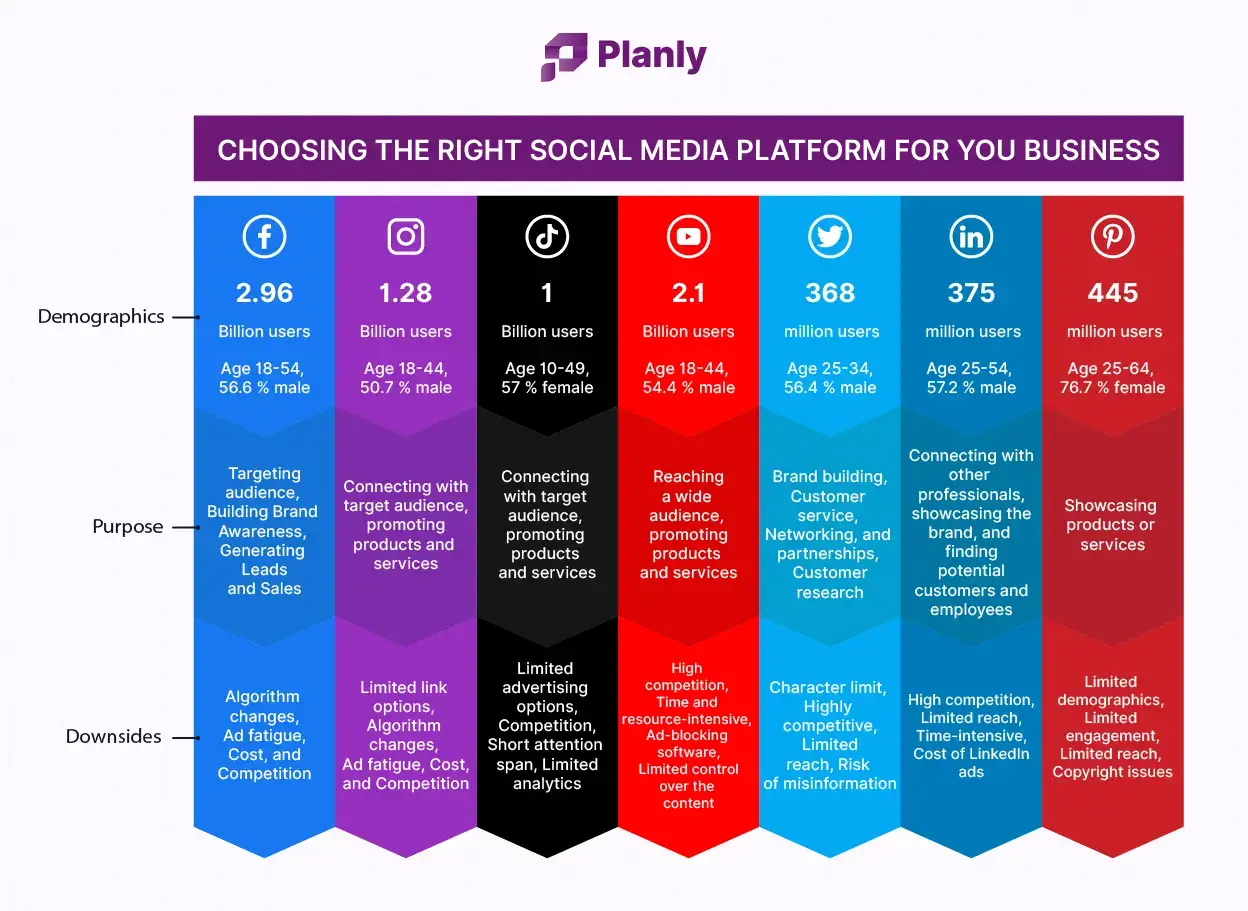In today's digital world, small businesses face the challenge of standing out in a sea dominated by larger companies. However, social media levels the playing field, offering smaller entities a powerful platform to amplify their brand and reach a wider audience.
It is where strategic use of social media for small businesses becomes crucial for growth and visibility.
7 Ways to Grow Your Social Media Brand
- Craft a Compelling Brand Story
- Master the Art of Engagement
- Visual Identity: Consistency Across Platforms
- Choose the Right Platforms
- Analytics: The Roadmap to Improvement
- Stay Ahead of the Curve
- Build Relationships Through Collaboration
1. Craft a Compelling Brand Story
A compelling brand story is the cornerstone of a successful social media presence. It's not just about what you sell but the values, mission, and experiences that define you.
Consider TOMS Shoes: their one-for-one giving model isn't just a business strategy. It's a narrative that deeply resonates with their audience.

Your story should be honest, relatable, and consistently communicated.
Share your journey, celebrate milestones, and spotlight customer experiences that reflect your brand's ethos. Remember, people connect with stories, not sales pitches.
Consistency in your story across all platforms reinforces your brand's identity.
A local coffee shop, for example, might share the story of how they source their beans, involving their audience in every step from the farm to the cup.
It showcases their commitment to quality and builds a narrative that customers can participate in.
2. Master the Art of Engagement
Engagement is the lifeblood of social media success. It's more than just posting content; it's about creating a space for conversation and community.
Engage your audience with questions, respond to comments, and create interactive content like polls or challenges.
For example, a boutique could engage customers by asking them to vote on new product lines.
It not only boosts interaction but also gives valuable insights into customer preferences.
Encouraging user-generated content is another powerful tool.
Invite your followers to share their experiences with your product or service.
It provides authentic platform content and fosters a deeper connection with your audience.
3. Visual Identity: Consistency Across Platforms
The visual aspect of your social media presence is crucial. A consistent brand design across different platforms aids in creating a recognizable identity.
It is where tools like VistaCreate come in handy. Brand Kit by Vista offers templates for all social media platforms, ensuring your visuals remain consistent whether you post on Instagram, Facebook, or LinkedIn.
This uniformity in design enhances brand recognition, making your business more memorable and trustworthy to your audience.
Balancing creativity with consistency is key.
While maintaining a consistent color scheme and logo placement, experiment with different layouts or graphic styles that resonate with your brand's personality.
It keeps your content fresh and engaging.
4. Choose the Right Platforms
Choosing the right social media platforms is vital. Your target audience's presence dictates where you should focus your efforts.
For example, a B2B company might find more value in LinkedIn, while a fashion retailer could benefit more from the visual appeal of Instagram or Pinterest.
Quality over quantity is essential.
It's better to excel on a few platforms than to have a mediocre presence on many.
Research and understand the nuances of each platform.

For instance, X (formerly Twitter) is great for quick updates and engaging in trending topics, while Instagram is ideal for visual storytelling and branding.
5. Analytics: The Roadmap to Improvement
Analytics should guide your social media strategy. Regularly review engagement rates, follower growth, and click-through rates.
This data helps you understand what resonates with your audience.
For example, if videos get more traction, investing more in video content might be time.
Set specific goals and use analytics to track your progress.
Whether it's increasing brand awareness or driving sales, having clear objectives helps you measure the effectiveness of your strategies and make informed decisions.
6. Stay Ahead of the Curve
The digital landscape is constantly evolving, so adapting your strategy is crucial. Stay informed about the latest trends and algorithm changes.
Embrace new features like Instagram Reels or TikTok challenges to keep your content fresh and relevant.
For instance, a small clothing brand participating in a trending TikTok dance challenge could showcase its products in a fun, engaging way, attracting a younger audience.
It's also important to listen to your audience. Their feedback can provide valuable insights into emerging trends and preferences, helping you stay ahead of the curve.
7. Build Relationships through Collaboration
Collaborations can significantly expand your reach on social media—partner with influencers or other businesses that align with your brand values.
It can introduce your brand to a new audience and add credibility. For example, a small skincare brand could collaborate with a well-known wellness influencer for a product giveaway.
It increases visibility and leverages the influencer's trust with their followers.
Remember, the key to successful collaboration is authenticity.
Choose partners who genuinely resonate with your brand and can add value to your audience.
This approach ensures that any collaborative effort feels organic and genuine rather than a forced promotion.
Final Thoughts
In conclusion, by,
- crafting a compelling brand story,
- engaging with your audience,
- maintaining a consistent visual identity,
- choosing the right platforms,
- analyzing your performance,
- staying updated with trends and
- building meaningful collaborations,
your small business can significantly impact social media.
Embrace these strategies, and watch your brand grow in this dynamic digital landscape.
Ultimately, the journey of amplifying your small business on social media is both an art and a science.
It's about telling a story that resonates, creating genuine connections, and consistently presenting your brand in a recognizable and engaging way.
By leveraging the right tools, staying adaptive to trends, and understanding the unique dynamics of each platform, you can transform your small business into a significant player in the digital arena.
Remember, social media is not just a marketing tool; it's a platform to build and nurture a community around your brand.
Embrace this journey with passion, creativity, and strategic thinking, and you'll find that your small business can have a significant impact.



